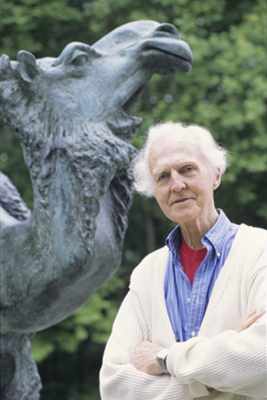H. Frederik Nijhout, John Franklin Crowell Distinguished Professor of Biology

Knut Schmidt-Nielsen wasn’t just the preeminent physiologist of the second half of the 20th century. He changed the way physiology was taught.
When he published “Animal Physiology: Adaptation and Environment” in 1975, physiology courses focused entirely on human physiology. But Schmidt-Nielsen’s textbook tackled the subject from a comparative perspective, taking biology by storm. It went to five editions, was translated into eight languages and became the leading physiology textbook of its time. Every physiology text since — as well as every introductory biology text — uses that comparative approach.
Born in Trondheim, Norway, and trained under August Krogh, the preeminent physiologist of the first half of the 20th century, much of the early work that drove Schmidt-Nielsen’s comparative method sought to understand how animals survive in extreme environments. It started with his curiosity about how sea birds like gulls survived by drinking sea water.
With the exception of whales, other birds and mammals cannot do this: If we depended on seawater, we’d quickly die by dehydration. The salt in seawater is three to four times more concentrated than the salt in our blood, so it causes our blood cells to shrink and die. The only way to survive is to get rid of the salt by producing urine that is more concentrated than the seawater.
Schmidt-Nielsen discovered that seagulls have a special pair of organs on top of the skull, above the eyes, that efficiently extract salt from their blood. He called them salt glands. The brine solution those glands produce exits via the nostrils, which is why it is common to see seagulls with a drop of liquid hanging from the tip of their bill. Salt glands have since been found in many marine animals, from sea turtles to marine iguanas, albatrosses, penguins and sharks. They appear to be the universal solution to surviving on seawater.
Schmidt-Nielsen is probably best known for his discovery of how camels survive in the desert, walking in full sun without drinking for weeks — conditions under which we and other animals would die of dehydration and heat stroke. Spoiler: it has nothing to do with the hump.
Just like the water desert of the salty open ocean, the sandy desert of the Sahara, where Schmidt-Nielsen did his work, poses difficult challenges for comparative physiology. As it turned out, there was not a single solution for surviving but several quite different ones, all working in unison.

First, there is the camel’s thick fur, which provides an insulating layer that slows down the blazing sun’s heating impact. Second, camels are basically able to store the sun’s heat during the day and shed it at night. At night, deserts are cold, and camels let their body temperature drop to a level that is hypothermic for humans. During the day, their body temperature rises gradually to what for us would be a near fatal fever. Neither of these two mechanisms would be any help for a small animal. It is the large body size of camels that enables them to store a large amount of heat.
A third adaptation are the camels’ enormous, convoluted nasal passages called turbinates. When dehydrated, these are encrusted with proteins and other molecules that can absorb water. When the camel exhales, moisture in its breath condenses in the turbinates and the camel exhales dry air. When the camel next inhales, the dry desert air evaporates the water on the turbinates, bringing moist air into the lungs. This mechanism allows camels to largely avoid respiratory water loss.
Combined with other adaptations — including the ability to tolerate dehydration and a rather high salt concentration in their blood, plus the ability to consume enormous quantities of water without going into osmotic shock when they are at last able to drink — the camel is a perfectly desert-adapted animal. None of these features by themselves would be sufficient, but acting in unison they allow the camel to survive in the desert.
Schmidt-Nielsen received numerous awards and recognitions for these kinds of insights, including election to the National Academy of Sciences (USA), the Royal Society (London), the Académie des Sciences (France), the Royal Norwegian Academy of Sciences and the Royal Danish Academy. In 1992, he received the International Prize for Biology, presented by the Emperor of Japan.